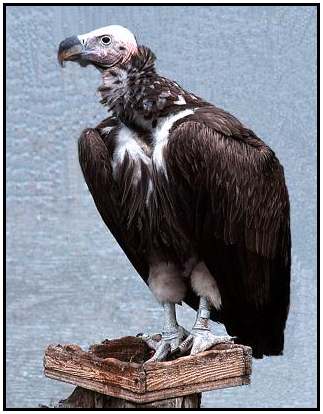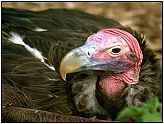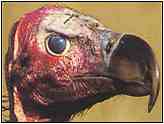Lappet-FacedOrder: Falconiformes. Family: Accipitridae. (Old World vulture). Scientific Name: Torgos tracheliotus Common Names: Lappet-faced Vulture, Nubian Vulture, or African Eared Vulture. Conservation Status: Threatened. Numbers are most prolific in Somalia and south-western Africa where it is often found in groups of one hundred or more. In areas where the birds are fewer it commonly gathers in small groups of eight to ten, and where numbers are low it can be found living in pairs or alone. Rescue & Recovery: Captive breeding.
Lappet-Faced Vulture (Photograph Courtesy of Bill Strahle Copyright ©2000)Geographical Range: Africa. Wide-spread in arid areas of the Sahara. Stretches as far as Somalia in the east and the Cape in the south. Found up to a height of 5,000 metres in Ethiopia. In the non-breeding season is a visitor to Egypt. Occasionally sighted in the Pyrenees and has ventured as far as the dead Sea to breed. Habitat: Resident in semi-deserts, open bush, or thorn scrub. Prefers arid conditions. Physical Characteristics: This is the largest African vulture and among the rarest of all vultures. It has a wingspan of 2.6 metres and stands more than one metre tall. The Lappet-faced Vulture is named for the loose skin (lappets) which hang from the red featherless head; the lack of feathers saves the difficulty of cleaning after feeding. The ruff at the base of the neck and the overall body colour is a chestnut brown, while the upper part of the legs are covered in white down. The wings are very broad and designed to allow long periods of gliding and soaring without wasting energy in flapping.
Lappet-Faced Vulture (Photograph Courtesy of Kurt Knoll Copyright ©2000)Of all the vultures the Lappet-faced would have the most formidable bill. Though useful for opening up a carcass, the bill comes in for little use when it comes to making noise as the lappet-faced Vulture is silent apart from hisses, grunts and yelps. It has a life span of around twenty years, compared to the fifty or sixty years of the California or Andean Condors. Male birds are smaller than females. Young birds are rather dull including over the head and neck. Food: Often associates with other vultures at carcasses, waiting until it sees the small Hooded Vultures are safe before itself approaching to feed. Will also eat birds eggs, kill small animals and catch termites or locusts. Has been seen to attack both young and adult flamingo, but mostly confines itself to carrion. Starts foraging early in the morning, just after sunrise when the thermals are strong enough to carry the birds aloft. The Lappet-faced Vulture can spot a carcass just over 1.6 kilometres away. When several species of vulture gather at a carcass protocol is determined by size and strength of beak. In this hierarchy, the Lappet-faced Vulture rips opens the cadaver and attacks the skin and offal; the Hooded Vulture digs out the softer portions of meat; then the Bearded Vulture polishes off what remains. They are an aggressive vulture and will often attack other species to steal their share of the food. When threatening others it runs forward with head lowered, neck outstretched, feathers of the back erect and wings widely spread. However, even the Lappet-faced Vulture will give way if the surly Marabou approaches wanting a share. After spending the day searching for food it returns to roost, usually in an acacia tree, about two hours before sunset.
Lappet-Faced Vulture (Photograph Courtesy of Bill Strahle Copyright ©2000)Reproduction: No mating displays have been noted. Nests are built in acacia or baobab trees, unless there are none in the vicinity, in which case rocky ledges are a second option. A huge nest is built, often six months in advance of laying. This is made of sticks and lined with grass, camel hair and rags. The female lays a single white egg with spots and both partners take turns at incubation for the following two months. Newly hatched chicks weigh about 200 grams and are covered in a thick down. Even this early in their lives the bill is noticeably heavy and the lobe-like facial flaps from which the birds get their name are present at hatching. . Initially the young are fed on regurgitated food; this is followed by large pieces of meat. Should the chick feel in danger it remains quite motionless, with its beak open wide and feigning death. After 110-120 days they somewhat reluctantly take flight, though young then remain with their parents for a further month, sometimes two. By this time they have gained their full adult plumage, the only notable difference being a whiter neck. These vultures probably do not breed every year and pairs may patrol different territories during non-breeding years. Thumbnails (Click For Full-Size Image):
|






